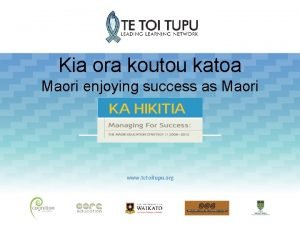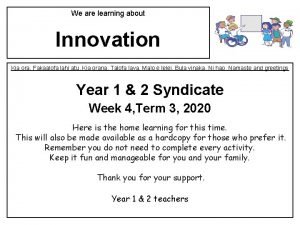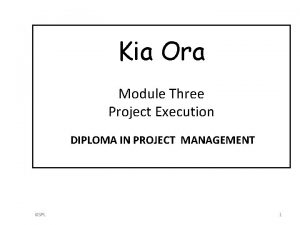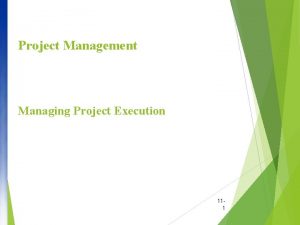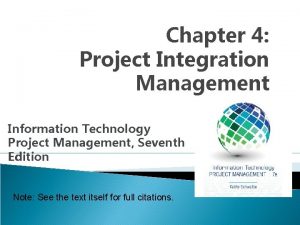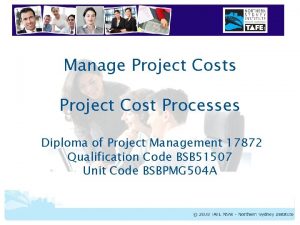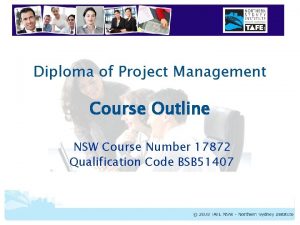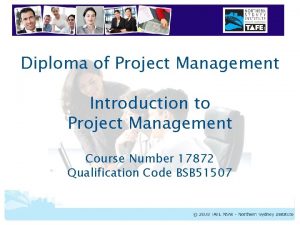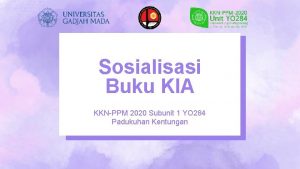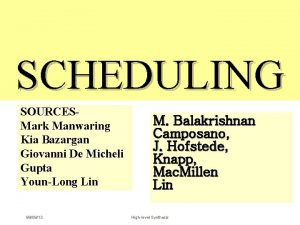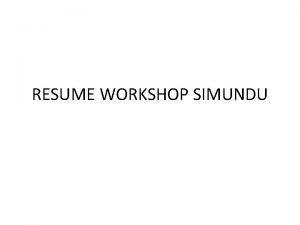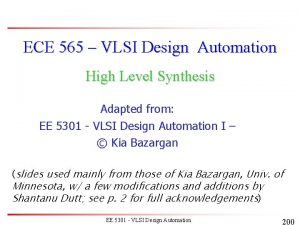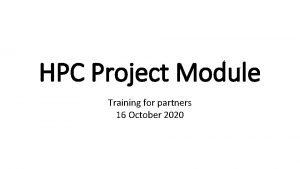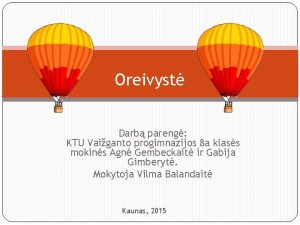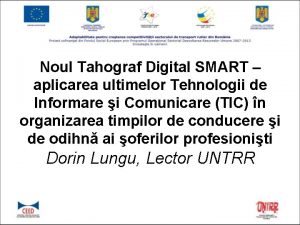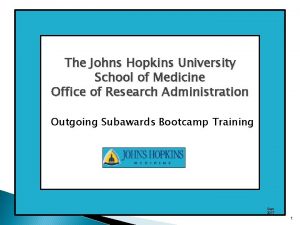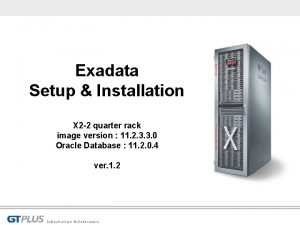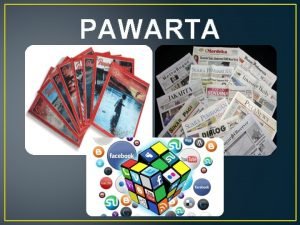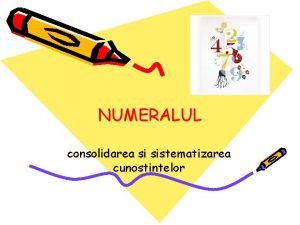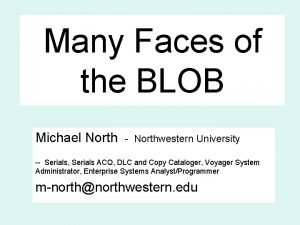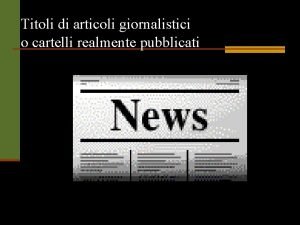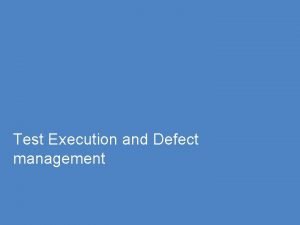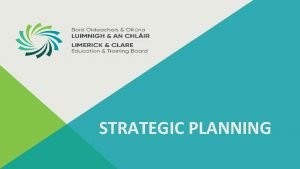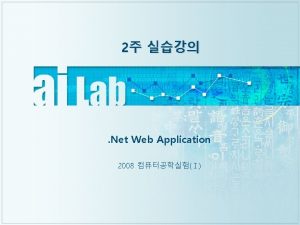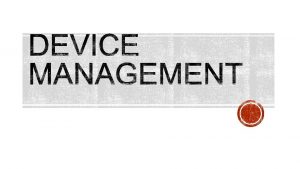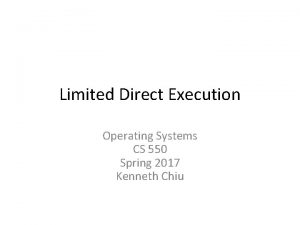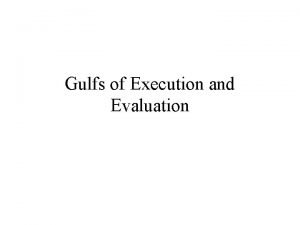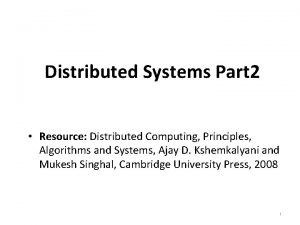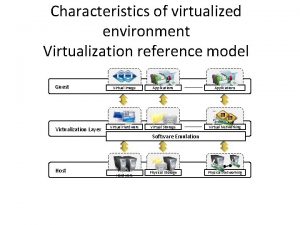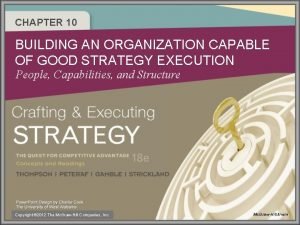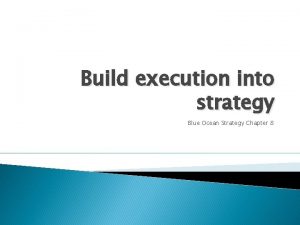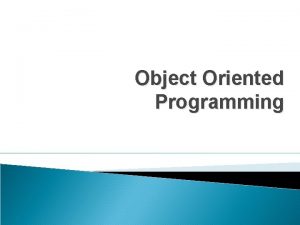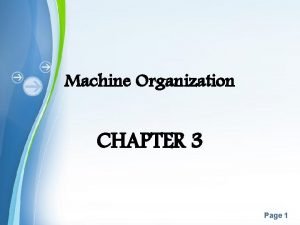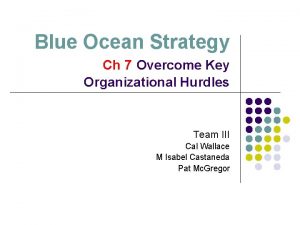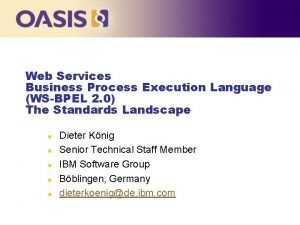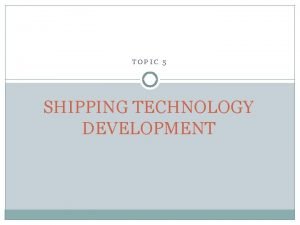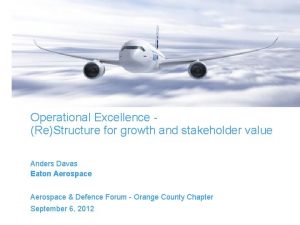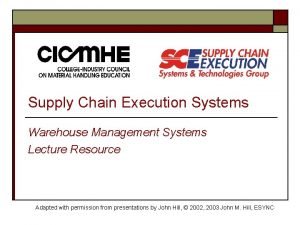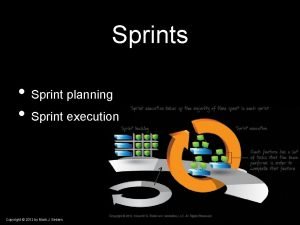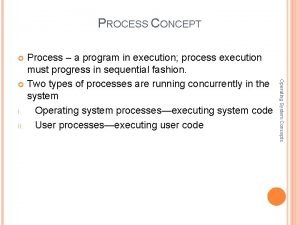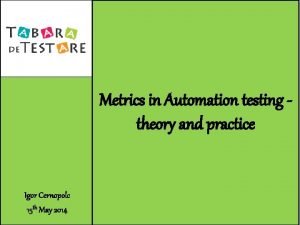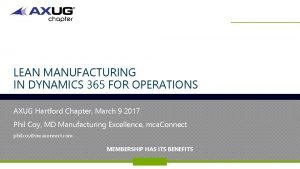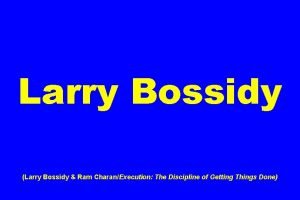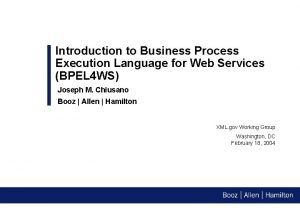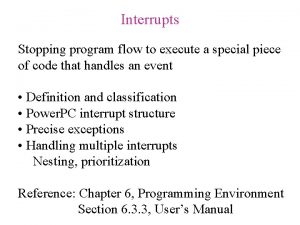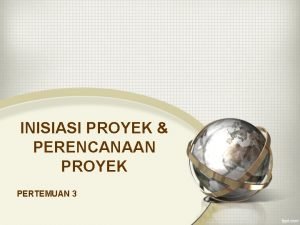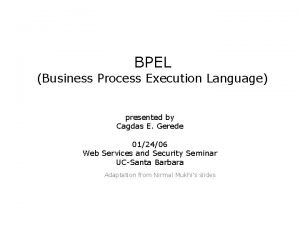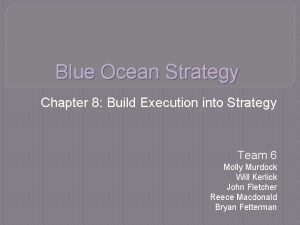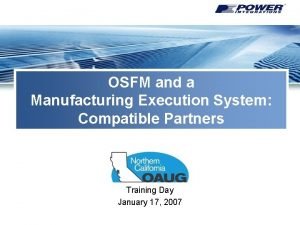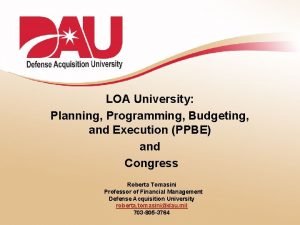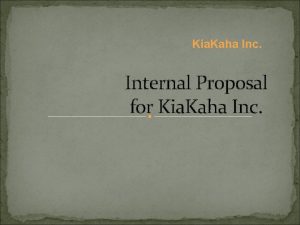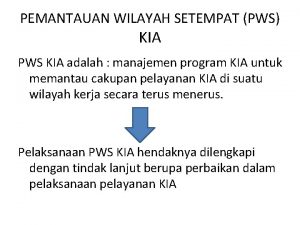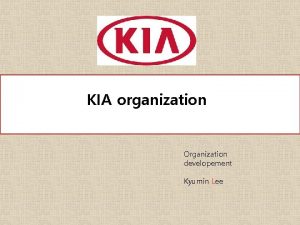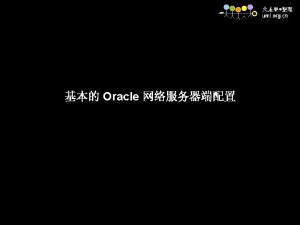Kia Ora Module Three Project Execution DIPLOMA IN






















































































































- Slides: 118

Kia Ora Module Three Project Execution DIPLOMA IN PROJECT MANAGEMENT ©SPL 1

Execution Phase 1. Project execution is the third phase of the project life cycle when our project plan is put into action. 2. We get everyone focused, procure materials, assign tasks (delegate or contract out), make sure the work is done properly to create required deliverables and present them to our sponsor and client for signoff. 3. Typically, this is the longest phase of the project life cycle, when most resources are used, and - yes – when most problems arise. 4. Good leadership, communication and teamwork is needed to get the work done to specification, within budget and on time. 5. When variations (changes) are proposed, their appropriateness needs to be assessed before they are approved and implemented. 6. While risk and issues management continue during execution, unanticipated situations (issues) will arise, which we need to deal with. 7. Sometimes when circumstances change, forecasted benefits may no longer justify the project investment, but that’s our sponsor’s call.

Revision: Estimating Time • • We estimate effort (in labour-hours) for a task, then translate this effort into calendar-time. A 20 -hour task might take 2. 5 calendar days of effort, or 2 more exhausting days with overtime. However, it could also take a week if we have to wait for materials, equipment, a preceding task to be completed, critical information from the client, or need to stay home with a sick child for two days. The translation of effort into calendar time is based on estimates of how many effective hours we can spend on project tasks per day, any interruptions or emergency requests we might get, meetings, and all the other places into which time disappears. Typically, only 60 percent of the time we spend at work is productive, which is far less than the assumed 100 percent effective time on which some project schedules are optimistically based. Also, people working on multiple projects take longer to complete tasks because of time lost switching between them.

Revision: Delphi Technique • Delphi works on the principle that multiple heads are better than one. The Delphi estimation method asks a small team to anonymously generate individual estimates given a task description. • Participation by multiple estimators and the use of anonymous estimates to prevent one participant from biasing another makes the Delphi method more reliable than simply asking a single individual for their best guess.

Revision: Record Actuals Where do we get historical data to improve our ability to estimate future work? The answer is, "If we write down what actually happened today, that becomes tomorrow’s historical data. " Unless we record the actual effort or time spent on each task and compare this to our estimates, we’re unlikely to improve our estimating ability.

Revision: Contingency is included in an estimate to implement responses for identified risks should they actually happen. The authority to spend contingency monies normally rests with the project sponsor. Contingency time and money is not “fat” or there to compensate for poor estimating. If a risk does not occur, the contingency should not be used. So a project budget is composed of the estimated cost, plus a contingency for identified risks, plus a management reserve for unidentified risks. And a private enterprise contractor’s price would also include a profit margin. (As part of the bid process we might ask contractors to provide a breakdown of their quote that also shows their profit margin. )

Risk and Expected Monetary Value Question. Which is the lesser risk? 1. 50% chance of winning $200 2. 50% chance of winning $600 and 50% chance of losing $200 Answer. We can calculate the Expected Monetary Value (EMV) of each choice for comparison: 1. EMV = 50% x $200 = $100 2. EMV = (50% x $600) – (50% x $200) = $200 So, the expected value of situation 2 is twice as much as the first one, and is thus the lesser risk. But don’t worry if you picked the first one; that’s a simple cognitive bias we often have called loss aversion. Losing things is generally emotionally stronger than gaining them. There may be occasions when we’re not making the best decisions in our projects because of such loss aversion.

Revision: Quality Rules 1. 2. 3. 4. 5. Project quality is about compliance with specifications, which to be useful must be relevant, understandable, unambiguous and measurable. Deming told us : “If we can’t measure it, we can’t manage it. ” Specify for quality right from the start, not an afterthought when problems arise. Use established standards wherever appropriate. The quality objective is to do it right, first time, every time, since rework is expensive. And quality is still important even when the auditor has gone home.

Revision: Risk Log Considerations • This log is established by the project manager during the project • • conception phase and updated continuously throughout the project life cycle. Any stakeholder should be able to log risks at any time, and thus the log should be readily accessible electronically or in hard copy format at the project site office. But have only one log per project to avoid confusion. Related risks should be logged separately where practicable to ensure their individual analysis and response. Typically the project manager would oversee risk analysis and authorise responses or recommend such responses for the project sponsor’s approval should the proposed response exceed mandated time and costs constraints as per the Project Charter. Risk should be an agenda item at every meeting.

Revision: Project Value Management • • Once the draft plan is prepared we might then see if we can make it more efficient through a project value management (PVM) intervention. PVM is the systematic study of a project to identify ways to achieve functionality at lowest cost without adding risk or without loss of performance. Some expressions equivalent to Value Management are Value Methodology, Value Analysis, Value Engineering, and Value Optimisation. It’s potentially effective for all types of projects, but best results are usually obtained with larger and more expensive construction projects. PVM usually adds greater value if applied prior to project execution, but might also be undertaken periodically during project execution. PVM intervention is in the form of a study (typically of one day’s duration) controlled by a facilitator and attended by experts and key stakeholders. Unfortunately, PVM is often only initiated when project budgets seem insufficient or profit margins are under pressure.

Revision: Roles and Responsibilities Before implementing a project it’s important to ensure that roles and responsibilities for those involved are clearly understood. We must be prepared to unambiguously assign each task to a single owner - employee or a contractor. And task completion criteria must be clear.

Managing Up • Sponsors need our cooperation, reliability and honesty. And we project managers rely on our sponsors for making connections with the rest of the organisation, for setting priorities, and for obtaining critical resources. If the relationship is rocky, then it is us who need to manage it. But, managing upward doesn’t mean sucking up, covering up, manipulating or getting involved in office politics. • At a minimum, we need to appreciate our sponsor’s pressures, and his or her strengths and weaknesses. What is their preferred style of working? Do they like to get information through emails, formal meetings or phone calls? Without this information, project managers are flying blind and unnecessary conflicts, misunderstandings, and problems may arise. • Project sponsors, like everyone else, are imperfect and fallible. They don’t have unlimited time, encyclopedic knowledge, or extrasensory perception; nor are they our evil enemies. Keep them informed.

Revision: RACI Responsibility Matrix Project Team Members WBS • R = Responsible. For a given project task, the person (Role Number) labeled R is responsible for doing the work. • A = Accountable. The accountable person is the one who approves the work completed by those responsble. • C = Consulted. People who provide necessary information and must be consulted. They're often experts whose knowledge is needed, even though they aren't doing the work themselves. • I = Informed. People or groups of people who will be affected by the task and need to be kept informed on progress.

Preparing a RACI Matrix 1. 2. 3. 4. 5. 6. Identify all the tasks involved in delivering the project and list them on the left-hand side of the chart usually in completion order. Identify all the project roles and list them along the top of the chart. Complete the cells of the chart identifying who has the responsibility, the accountability and who will be consulted and informed for each task. Ensure every task has a role responsible and accountable for it. No tasks should have more than one role accountable. Resolve any conflicts where there is more than one for a particular task. Share, discuss and agree on the RACI Matrix (sometimes referred to as a Responsibilities Assignment Matrix or RAM) with our stakeholders before our project starts.

Execution Steps 14. Procure Resources Once the project plan is approved, resource procurement contracts may be finalised. 15. Assign Work Project work packages are formally delegated or outsourced (ie, contracted out) and work commences. Having the right people available for the right tasks at the right time is the challenge. 16. Monitor Progress Once underway we check for variance (difference between planned and actual progress) and take corrective action where needed or sometimes re-plan the balance of the project. 17. Manage Execution We manage the work, stakeholders, variations, risks and issues, documentation, report progress, and lead the project team. 18. Produce Final Deliverables We check the completed final deliverable(s) against acceptance criteria and prepare for handover.

Personal Productivity There are many ways to help ensure we make best use of our time, such as the need to minimise interruptions etc. Two proven ideas in particular that may help us as project managers are: 1. Prepare a daily prioritised “To Do list”. Prepare this the last thing the day before. If possible schedule project work for periods when we usually have more energy – typically mornings. And leave our routine BAU work for the afternoons. 2. Set work priorities. Apply Stephen Covey’s time management matrix to prioritise our work list. This popular matrix encourages us to separate important jobs that add value from the merely urgent or pressing jobs. Of course if a job is both important and urgent it’s likely to top our list of priorities, but even top priority jobs can usually be delegated, which is an important process that we’ll consider soon.

Use Prime Time If we have both project and business-as-usual work, it is usually better to schedule the more demanding project work for that time of day when your energy levels are highest, assuming you have such personal scheduling flexibility. SPL Page 17

Daily To Do List Our personal daily To Do list is a very helpful tool to ensure best use of our time and it’s nice to firmly cross off those jobs as we complete them 1. 2. 3. 4. Rather than an electronic To Do List it’s often better to have a hard copy permanently displayed as a reminder. Best to prepare our To Do List last thing each workday in order to have a running start at the next work day, otherwise we’re more vulnerable to procrastination, distractions and interruptions. But, don’t be too ambitious about what can be accomplished in one day. Prioritise our To Do List. Typically we prioritise our work according to our job description, consistency with core values, contribution to our project goals, anticipated benefits, assigned deadlines, and perhaps consequences of not doing it. We may need to say “No” on occasions. Prioritising does not necessarily mean focusing on easy or safe jobs, those that we like doing or those that are highly visible. One very useful tool for prioritising our work is Stephen Covey’s time management matrix.

Personal Time Management and Productivity Time management is a basic skill for project managers. If we can't manage our own time, how can we expect to manage our teams? The Workbook contains a variety of exercises designed to improve personal project productivity. They are for you to complete in your own time if you wish. However, we will apply Stephen Covey’s matrix to 40 possible project issues, which tool is very applicable for busy project managers who need a good sense of priorities. Consider too: 1. 2. 3. 4. 5. 6. 7. Time Management: 80/20 Rule. Using MS Outlook for scheduling project team meetings. Multi-tasking versus mono-tasking. Personal productivity analysis. Process audit checklist. Overcoming procrastination. Managing interruptions

Manage Interruptions Since it probably takes 5 minutes to get fully back on track after a 30 -second interruption, it is important to eliminate or minimise interruptions. Some ideas: 1. Have two or three short blocks of “open time” throughout the day to update or assist other people. 2. Set aside a dedicated work time where interruptions are not allowed and make sure it’s respected. 3. Actively minimise distractions by turning off email or sending calls directly to voicemail.

Lessons Learned • Project teams should learn to identify lessons during projects and record them for inclusion in a report at the end of the project. • Don't leave this until the end of the project when memories have faded. • Lessons can often be discovered by asking these three questions: 1. 2. 3. What went right? What went wrong? What could have been better? • Once lessons have been captured, they need to be made available to all project teams to help them avoid repeating the problems of the past.

Personal Time Management Stephen Covey’s Matrix IMPORTANT NOT IMPORTANT URGENT NOT URGENT CRISIS PROACTIVE 1 2 Action Schedule REACTIVE WASTE 3 4 60 -80% PM’s work • project planning • pre-empting problems • relationship building estimate work effort Discard Plot time in our diary now!

Delegation • While there is some project management work that we most appropriately do ourselves. The other two options in order to get the work done are either to contract out the work packages or to delegate the work packages to those people from within our organisation who have been assigned to our project. • Delegating not only provides team members with opportunities to hone their skills, but it also shows that we trust them to get the job done — no one likes being micromanaged! • But, remember that we remain responsible for the project and regularly checking in with our team members is a smart way to help ensure proper completion of all delegated tasks. .

Delegation Practices 1. Be clear about the required output. What will be produced? How will the quality of those things be determined? What things are part of this? What things are not part of this? What’s the completion deadline? 2. Clearly define limits of authority. Can they hire others to work with them? Are there spending and time constraints. 3. Agree on the frequency of visits, feedback, meetings and reports between ourselves and the person to who we delegate the task. Stand ready to help, yet stay hands-off as much as possible. 4. Resist taking back a delegated job because we can do it better or faster. Usually better to coach them. 5. Give timely praise and credit for good progress and proper completion.

Finding a Scapegoat To be an effective project manager, we need to delegate to team members. Select person Brief them What would we do differently next time in order to improve? Confirm they understand job New job? No Evaluate result Monitor progress Agree control arrangements Yes Check their proposed strategy

Some Delegation Mistakes • Delegating the best jobs to those team members we like, and the worst jobs to those we don’t like. • Being vague about what’s to be accomplished – result is unclear. • Failing to thank our team members when they properly complete the delegated task. • Forgetting that we remain overall responsible for the timely and proper completion of the task. • “Drop delegation” - abdicating rather than delegating. • Micro-managing or “snoopervision”. • Accepting “upwards delegation” and doing their work or solving their problems, rather than advising and supporting them through the process.

Degrees of Delegation We delegate authority to undertake project tasks for three main reasons: 1. To free ourselves up to do other more appropriate tasks. 2. To have the most suitable team members do the tasks. 3. To develop team members. Delegation doesn’t have to be an all-or-nothing proposition, where we either make all decisions ourselves or we withdraw from the situation entirely. We need to consider their ability and willingness to do the job and apply the following five progressive degrees of delegation: 1. “I’ll decide. ” (autocratic project management style) 2. “We’ll discuss; I’ll decide. ” (participatory) 3. “We’ll discuss; we’ll decide. ” (consensus) 4. “We’ll discuss; you decide. ” (advisory) 5. “You decide. ” (empowering)

Delegation Continuum High E D C Their current performance If in doubt about their level of performance, it’s usually better to err towards more control - at least at first - then review. B A Low Your control High Their control and buy-in Low A “I’ll decide. ” (autocracy) B “We’ll discuss. I’ll decide. ” C “We’ll discuss. We’ll decide. ” D “We’ll discuss. You decide. ” E “You decide. ” (empowerment)

Delegation Exercise As the project manager to what extent would we delegate our authority to the team leader(s) in each of these briefly described circumstances. We will need to make some reasonable assumptions about each situation in order that we can assign an A, B, C, D or E - first individually and then by group consensus. Project Manager Team Leader Team Members

Another Option: Contracting • When projects need knowledge and skills that our employees don’t possess or they aren’t currently available, we may turn to outsourcing to solve the problem. Outsourcing means just what it says - going "out" to find the "source" of what we need. We can outsource any work - project work, routine work and procurement. • So outsourcing is about contracting work out to an external party – a contractor (who might also be referred to as a supplier or consultant). Outsourcing could include both local and overseas contracting, the latter is sometimes called offshoring, sometimes motivated by lower labour rates. (Some might argue that offshoring project work to low-paid workers is an unethical choice. ) • Organisations usually focus on their core competencies and outsource where they have a shortage of expertise or time. (Yet from the workers’ standpoint, outsourcing may contribute to job insecurity, and some organisations are now drifting back to doing more tasks themselves in order to develop or preserve their expertise and self-sufficiency.

Outsourcing Project Work We may need to outsource some work and/or procure some material from external sources, which presents both opportunities (to be exploited) and threats (to be avoided or minimised). Opportunities Threats For government, more expensive purchases require tendering. This process is sometimes managed as a separate procurement project. Also, contracts need to be agreed to help ensure that opportunities are realised and the threats of contracting are avoided or minimised. The resultant contract is a risk management tool. The advantages and disadvantages of contracting are best realised or avoided through selecting the right contractor, rather than through over reliance on contractual terms and remedies. ‘Due diligence’ is about evaluating prospective providers. A written contract must be agreed and signed before work starts.

Ten Contracting Do’s 1. Do employ the right people. If we haven’t got them, hire them. If we can’t hire them, treat this as a risk. 2. Do not reveal the project budget, since to do so may give contractors an idea about how much to charge. 3. Do indicate to contractors if there is competition, but don’t reveal details. 4. Do allow sufficient time for contractors to properly prepare their quotes, otherwise expect their figures to be inflated. 5. Do ensure that the contractor uses competent people – preferably those subcontractors who have been qualified by a third party. 6. Do have a written contract before work starts. 7. Do monitor their work against the agreed schedule and quality standards. 8. Do be fair and open, don’t exploit the contractor, and should problems arise, discuss these openly. 9. Do co-operate to solve problems, in preference to mediation, arbitration or adversarial litigation. 10. Do require that variations suggested by the contractor be approved by you in writing before they are implemented.

Some Contracting Risks Contract clauses usually exploit or mitigate the risks of outsourcing. Opportunities • • • SPL Fixed cost Fresh perspective Easier to hire and fire Frees up own resources Avoids undesirable jobs We can learn from them Impresses our client Penalties can apply No capital investment We can be selective They want future contracts Page 33 Threats • • • Ability over-rated Lack of schedule flexibility Time and cost of tendering Security and confidentiality Demotivates own staff Deskills own organisation No priority attention Less control Scope creep more likely Market vulnerability They learn at our expense

Project Procurement Project procurement is the process we use to get materials for the project and get work done on the project by people outside our organisation. Procurement may involve competitive tendering to ensure best value for money. Procurement also includes arranging contracts and managing them (contract management) after they have been awarded. Procurement is usually organised by the project manager, although some organisations may have a separate purchasing department to handle this function. A procurement might be regarded as a project in itself and on larger, more complex projects, personnel may be dedicated to procuring and managing the equipment, supplies, and materials needed for projects.

Employee or Contractor? • Who decides their work content, place of work, method of work and hours of work? • Who owns the tools, equipment, facilities, plant, premises? • Do they have other clients? • Do they pay their own expenses, insurances, professional levies, ACC, FBT, PAYE, and GST? • Are they a permanent and essential part of the organisation? • Are they employed continuously, or occasionally? • Do they have access to the personal grievance procedure? • Do they receive paid leave? • Did the parties envisage an employee or contractor relationship? • Are they in business on their own account? • Who assumes the risk and receives the rewards? • Who is responsible for engaging resources and delivering outputs? • Does the Consumer Guarantee Act apply? • Do they have insurance against loss of income and negligence?

Contractor’s Perspective • • • • Maximise the profit (price less cost) without performance loss. Get agreements in writing – clear, complete, correct, and specific. Ensure the job is in a known financial state at all times. Monitor and maintain progress against the contract schedule. Document all key communications. Confirm and claim variations as they arise – don’t let them accumulate. Enhance longer-term client relationships, but not by conceding every issue. Behave in a safe, legal and ethical manner at all times. Meet (but don’t exceed) obligations under the contract. Comply with all relevant legislation and statutory requirements – both national and local laws. Understand the contractual terms and the basis for the price, and preserve the margin. Settle concerns, disputes and issues properly and promptly through negotiation. Ensure all required insurances are in place before work starts.

Contract Manager’s Job 1. Determine whole-of-life costs of the 9. Be prepared to justify selection decisions purchase and obtain funding 10. Negotiate win : win agreements 2. Understand goods or services subject 11. Pre-empt procurement and contractual to procurement risks 3. Consult interested and affected 12. Identify hazards (e. g. , OSH) stakeholders 4. Prepare procurement plans 13. Monitor progress and performance 5. Produce effective solicitation documents 14. Arrange third-party reviews 6. Evaluate proposals and tenders fairly, consistently and reasonably 7. Sign agreements or arrange for their signing 8. Debrief unsuccessful tenderers 15. Implement contract obligations 16. Seek legal advice as needed 17. Promptly resolve issues 18. Manage variations

19. Resolve disputes by negotiation 28. Maintain effective business relationships 20. Comply with all applicable legislation 29. Promptly approve claims for payment 21. Manage retentions 30. Ensure funds available 22. Maintain preferred providers’ list 31. Evaluate deliverable/result/output against specifications 23. Approve sub-contractors 24. Maintain and retain records 25. Take joint responsibility for relationship wellbeing 32. Maintain confidentiality 33. Don’t be bull-dozed by contractors 34. Use the contract, don’t hide it 26. Report progress to senior management 35. Have interim and post-contract evaluations 27. Build trust, respect and credibility with contract partners 36. Where appropriate implement post-contract recommendations.

Contract Ethics • Declare personal interest that might be perceived to influence impartiality. • Don’t accept gifts or hospitality from contractors. • Provide accurate and impartial advice and information. • Respect confidentiality of information provided by contractors. • Invitations to Tender or Requests for Proposals should not be designed to exclude or include specific providers or products. • Don’t injure the reputation, image, brand or business of others.

NZ Public Sector Procurement Principles • • • Accountability – Public entities should be accountable for their performance and be able to give complete and accurate accounts of how they have used public funds. Openness – Public entities should be transparent in their administration of funds, to support accountability and to promote clarity and shared understanding of respective roles and obligations with external parties entering into funding arrangements. Value for money – Public entities should use resources effectively, economically, and without waste, with due regard for costs and benefits. Lawfulness – Public entities must act within the law, and meet their legal obligations. Fairness – Public entities are to act fairly and reasonably, and must be impartial in their decision-making. Integrity – Anyone who is managing public resources must do so with the utmost integrity.

Sustainable Procurement Sustainable - not jeopardising our future. Here are some examples of procurement sustainability: 1. 2. 3. 4. 5. Specify products and services considered to be sustainable Verify suppliers’ sustainable management standards Include a sustainability clause in contracts Rate supplier performance against sustainability criteria Assist suppliers to improve their sustainability performance

Getting a Quote 1. 2. 3. 4. 5. 6. 7. 8. Decide exactly what we want done, to what standard, and when we need it done by. Contact at least three providers, give them the same information and ask each for a written quote. Let each one know that you are getting others to quote. As a minimum the quote should show what work is to be done, start and finish dates, hourly rates, cost of material, and whether the total price includes GST. Tell the successful provider they have the job. We don’t have to tell the other providers who you chose or why, but it’s helpful to provide them with feedback. Try not to pay a deposit, especially a large deposit, and definitely don’t pay the total amount before the job is properly finished. Ensure the contractor checks with us before doing any extra work (variations) as this may mean we have to pay more than the quoted price or the work takes longer. If we choose to accept work above the quoted price, then shop around. Keep all paperwork – quotes, invoices, receipts. Even if you bypass the tender process and go straight to your preferred contractor, always ask for a detailed quote in writing. A quote is a legally binding agreement. Use the same process for an estimate (which is not a firm price but a realistic guess) but remember that the actual price or quote may be more or less than the estimate – seldom less.

Estimates and Quotes There can be a big difference between an estimate and a quote. An estimate is only a best guess at what the job will cost and the contractor is not bound by it. However, it is reasonable to expect it to be within 10 – 15% of the final cost. A quote is an explicit promise based on detailed specifications and is the price you pay, barring matters outside the contractor’s reasonable control or increases in the cost of materials or labour (if the contract allows this), or other variations. All estimates and quotes should be in writing. It’s unfair to use one quote as leverage to get a lower one from someone else. Be wary of low tender prices compared to others as it could mean the low tenderer has misunderstood the requirement or hopes there will be expensive variations, which will be more likely if our work scope and specifications are vague.

Be Wary of Big Deposits • If a contractor asks us for a big deposit, this should raise a red flag. • Anyone individual or organisation that pays a deposit for project contract work becomes an unsecured creditor if the contractor’s company fails. Unsecured creditors are at the bottom of the payment totem pole and seldom get back any or all the money they are owed. • So a good practice if a deposit is required, is to try to limit this to 10% of the anticipated total and thereafter only pay for satisfactorily completed work on a monthly basis. Retentions of 5 -10% might also apply. Although not a common practice, we might require that the deposit be held in a separate protected account pro temp. • As buyers we need to undertake due diligence – check the contractor’s financial situation and their capacity to do the job. We might also consider having any materials we have paid for stored at our own premises, rather than leave them at the contractor’s premises.

Procurement Process The full process typically consists of five main steps: Plan Procurement Solicit Responses Select Supplier Manage Contract Close Contract In fact, the procurement of a new item of equipment is best in managed as a project. While government departments are required to make more expensive purchases through competitive tendering, private organisations do not need to tender. The tendering process can be quite time-consuming and government departments are excused the process for genuine emergency purchases. Government is at present considering how the procurement process can be speed up and made more cost-effective.

Procurement Terminology There are several expressions used both in government and the private sector that relate to the process of inviting tenders or proposals: • A registration of interest (ROI) or expression of interest (EOI) is generally used to request information from suppliers that may be used to identify and shortlist potential suppliers before seeking tenders or proposals. • A request for proposal (RFP) is a formal means of seeking proposals for goods or services where we are open to innovation on the part of a supplier – that is, where the outputs and outcomes are important, not the process the supplier follows to deliver them. The RFP therefore normally invites suppliers to make a proposal based on broad specifications, with scope for variety and innovation. • A request for tender (RFT) is a formal means of seeking tenders to provide goods or services. It is used where the procurement specification or requirements are clearly defined.

Open and Closed Tendering The method of inviting tenders or proposals may be “open” (all possible suppliers are invited to respond) or “closed” (only some of the possible suppliers are invited to respond). A closed tender or proposal involves inviting a predetermined list of suppliers to respond without an preselection or pre- qualification process.

Types of Contracts Scope Definition minimal partial complete Number of Variations many several some Level of Uncertainty high moderate low Degree of Risk high medium low Typical Risk Allocation Client Contract Type CPPF Contractor CPIF CPFF FPPI FFP

Tender Evaluation 1. Lowest-priced conforming tender, where tender meets minimum requirements. 2. Two envelope system, where tenders are submitted in two envelopes; one envelope contains the price, and the other contains non-price attributes. 3. Contracting rating formula, where a contractor’s price is adjusting according to their previous performance 4. Weighted-attributes method, where tenders are evaluated against selection criteria each of which have different values.

Tender Evaluation The tender evaluation process should provide a fair comparison between the responses. The evaluation should be conducted by staff with the relevant skills and knowledge appropriate to the value and importance of the procurement. Conflicts of interest should be declared and resolved. The same evaluation method should be applied to each response. The weighted-attributes model is the most common model used in public sector procurement. This model seeks to balance the trade-off between price and quality, and it can be used for goods or services. Under this model, the criteria are weighted to reflect their relative importance. Each criterion in the tender or proposal is scored, and each is multiplied by the relevant weighting to give a weighted score. The weighted scores for each tender or proposal are summed to find the highest scoring tender or proposal.

Retentions !! As the name suggests, retentions are a portion of a payment (usually 5 -10%) withheld from a contractor for an agreed defects liability period (often months and sometimes years) as a guarantee of quality work and to help ensure defects are properly fixed. Similarly, most head contractors withhold the same percentage payment from their subcontractors. However, this practice places subcontractors at risk if the head contractor becomes insolvent. For example, some $18 m of subcontractors’ retention money was lost with the Mainzeal collapse in 2013. Our government is at present considering legislation to better protect subcontractors for work done. The main provision is that retentions be held in trust for subcontractors.

Contract Law A contract is a binding agreement, which to be valid must meet six criteria: 1. Intention of the parties to create a legal agreement. Intention 2. An offer by one party and acceptance by the other. 3. Each party must have made some contribution, called a consideration. 4. The parties must have the legal right or capacity to enter a contract. 5. The parties must have reached true and genuine consent. 6. The agreement must be legal in nature.

Voidable Transactions • • • Voidable transactions are one of the most controversial areas of insolvency. In mid-2013 the NZ Court of Appeal ruled that when companies go bust, liquidators can claw back payments made by an insolvent company up to two years before its collapse, a practice know as voidable transactions. Shocked contractors and sub-contractors have appealed this decision to the NZ Supreme Court, who have heard the case, but as at 2015 are yet to publish a decision. It seems that the current ruling means that contractors who have properly completed the work and paid their subbies and suppliers cannot be sure that these payments will not be recovered, leaving them to recover payments from their subbies and suppliers – fat chance? Hopefully our Supreme Court reverses this decision. The whole process seems to be a gravy train for lawyers. If the work is done as quoted and been paid for it then that should be the end of it. So if liquidators take the money back from the contractors, can the contractors go and remove their work or demolish it? Good news!! This last February NZ Supreme Court overturned a Court of Appeal ruling allowing liquidators to claim back payments made by a failed company for goods and services up to two years before its collapse.

Standard Form Contracts Standard form contracts are commonly used by businesses that provide services to large numbers of customers. They are offered on a "take it or leave it" basis. You won't be given the opportunity to quibble over details you're not happy with. Commonly, these contracts even include a clause giving the company the right to alter the terms and conditions as they see fit. This is why your electricity company can put up its prices, even though you haven't "agreed" to it. We can of course challenge such terms, since all contracts are an agreement between parties.

Some Legal Stuff • • • Breach. When someone doesn't fulfil their part of the contract. Damages. Money paid to compensate for a breach of contract. For "special" damages, you have to prove the exact amount the breach cost you. "General" damages cover things that can't measured, such as distress, humiliation and inconvenience. Frustration. This is when the contract can't be carried out because of circumstances beyond everyone's control. Say, for example, you hire a meeting room, but it's struck by lightning and burns down. If that happens, you don't have to pay, but you can't sue the owner for damages. Postal acceptance rule. If you write a letter accepting an offer, the contract applies as soon as you put the letter in the post. The only exceptions are if you were specifically asked to accept in some other way, or if posting a letter is unreasonable in the circumstances Email. An email message doesn’t necessarily constitute a binding agreement. Disclaimers on emails stating that the email is not an intention to enter into a legal agreement helps avoid having messages sent for negotiation purposes only that unexpectedly become enforceable agreements.

Email Contracts • Contracts created via electronic communications, or better known as ‘e -commerce contracts’, have become an increasingly popular in business practice. • Provided certain requirements are met, e-commerce contracts are enforceable. Just like any other form of contract, e-commerce contracts require an offer, acceptance and an exchange of value, all of which can be recorded electronically. • However, these electronic exchanges are often quick, with scant consideration given to the conditions. This can lead to an unclear and uncertain agreement, and possibly not the agreement we thought were agreeing to. And who knows who you were messaging and whether they have authority to enter into a contract on behalf of their organisation. Better that the parties meet face-to-face and the agreement is checked by our lawyer before we sign. • Also, be careful about e-commence contracts with organisations in other countries whose contract laws may be different.

Contract Cancellation Normally we can’t cancel a contract when the other party can still provide their side of the agreement. But this can change: 1. if the contract has a “termination” clause or specific term 2. if the other party agrees to accept our request to cancel the contract 3. If we have been given incorrect information about part of the contract 4. if the other party breached an important term or condition of the contract.

Force Majeure A contract term might read: “Neither party shall be held responsible for any delay or failure in performance of any part of this agreement caused by fire, flood, explosion, war, embargo, government requirement, civil or military authority, act of God, or other similar causes beyond its control and without the fault or negligence of the delayed or non-performing party. ” This means that if some unforeseen event prevents either party from performing their part of the contract, the non-performance will not be considered a contract breach. The party experiencing the event must inform the other party that its performance under the contract is delayed and if the delay lasts more than a specified period, say 30 days, the contract may be terminated by the other party. .

FIDIC Publications Engineers and contractors working on projects outside New Zealand, especially in developing countries, will benefit from using the following FIDIC international contracts: 1. Conditions of Contract for Works of Civil Engineering Construction: The Red Book 2. Conditions of Contract for Electrical and Mechanical Works including Erection on Site: The Yellow Book) 3. Conditions of Contract for Design-Build and Turnkey: The Orange Book) SPL Page

Tomorrow • Tomorrow we’ll focus on controlling, or managing, the project when actual performance is revealed, the project’s status is analysed, plans updated, projections made, problems solved, and corrective actions formulated and applied to keep our project on track. While we also continue to manage risks, issues, variations, stakeholders and documentation. In fact, strong communication among all stakeholders is what allows a project to evolve in an ordered way, instead of wobbling out of control. • Successful project implementation depends largely on effective leadership. We lead rather than manage people. We manage processes. The best project managers are also good leaders. They have vision, they motivate, they bring people together, and they accomplish great things. In fact, maybe project leader is a more appropriate title than project manager? In practice we are both leaders concerned with effectiveness and managers concerned with efficiency.

Welcome Back! TIME TODAY’S TOPICS 9: 00 • Revision and Motivation Audit • Monitoring Progress • Earned Value Analysis (what? ) 10: 15 Morning Tea Break 10: 30 12: 30 • Managing Variance • Trade-off Analysis (what? ) • More on Risk Management Lunch Break 1: 15 2: 45 • Groupthink • Team Problem Solving Exercise • Project Meetings Afternoon Tea Break 3: 00 4: 30 • Communication Skills • Project Leadership Exercises • Next Assignment and Presentations I’m confident that you will find these topics pretty straightforward, but experience with previous students tells me that those two items marked “what? ” may need us to work through them tutorial style. Time may not permit the leadership case study, but it can be completed in your own time if you wish. Answers are included.

Execute Phase – Main Steps Today’s plan is to tackle the red steps 16, 17 and 18. 14. Procure Resources Once the project plan is approved, resource procurement can be finalised. Contracts may need to be negotiated. 15. Assign Work Project tasks are formally delegated or outsourced (ie, contracted out) and work commences. 16. Monitor Progress Once underway we check for variance (difference between planned and actual progress) and take corrective action where needed or re-plan the project. 17. Manage Execution We manage the work, stakeholders, variations, risks and issues, documentation, report progress, and lead the project team. 18. Produce Final Deliverables We check the completed final deliverable(s) against acceptance criteria and prepare for handover.

Execution Realities • Sponsor is hopeless, hapless, helpless • and doesn’t accept reality. Project priority downgraded and we lose sight of the goal. • Project parameters start to look • totally unrealistic and now it’s evident that planning was based on insufficient data and guesswork. • Ballpark estimates prove to be wrong, but are now ‘official targets. ’ • • More and more anxious and demanding stakeholders appear and our client changes their mind yet again #@! – variations proliferate. Scope gallop predominates! Plenty of scary things that go bump-in -the-night (issues). Key workers unavailable and people don’t see themselves as working on one team. • Big variances becoming evident. • We’re tired, BAU is suffering, our family doesn’t recognise us, and the grass needs cutting!

Soft Skills can be Hard Too • Hard skills or the science of project management involve a variety of processes, tools and techniques. • Soft skills or the art of project management are the skills necessary for working well with others. • Without people, projects cannot happen. Thus, soft skills are at least as important as hard skills for our success as project managers. • They are complementary skills. We can't be wholly effective if we are only proficient at project scheduling and budgeting. We must also be good at dealing with people.

Barriers to Effective Teamwork A project team, often put together at short notice, usually has little time before it must perform. In addition: 1. 2. The team may be dispersed geographically. Its members may have other duties (other projects and business-as-usual) to attend to. 3. The most appropriate people may not be available. 4. Some team members may have hidden agendas. 5. Team responsibilities and roles may be unclear. 6. Some individuals may not be team players. 7. Poor communication among team members. 8. Discrimination can happen for reasons that range from gender or race to education or experience. 9. Lack of respect or acknowledgement for other team members’ opinions and contributions. 10. Unmotivated team members.

Top Motivators Motivated team members are generally more productive. Different things motivate different people and motivational drives often change over time. An NZIM survey found the following were the most frequently identified top 10 motivators (not in order): Ø Advancement/Promotion Ø Challenge Ø Development/Learning Ø Achievement Ø Pay/Financial Reward Ø Recognition Ø Job Security Ø Relationships Ø Variety of Work Ø Autonomy/Freedom SPL Page 66

Information Flows DELIVERS Work Package Managers Ø employees Ø consultants Ø contractors Ø suppliers DRIVES Project Manager Seeks timely, correct and relevant information in order to navigate project and keep stakeholders informed. DIRECTS Project Stakeholders Ø CEO/GM Ø sponsor Ø champions Ø user (customer) Ø client (owner) Ø steering committee Ø programme manager Ø line managers

Monitoring Progress We need to frequently check that execution is proceeding as per our plan and our plan is still fit for purpose. There is a trade-off between cost to monitor progress and value of resultant information. Project control should be costeffective and the need to monitor project performance will typically be influence by: Ø priority given the project Ø stakeholder expectations Ø size of resource commitment Ø risk assessment – high or low Ø cross-project dependencies Ø relevant legislation – OSH etc Ø allowable tolerance limits and parameter priorities Ø consequences of failure Ø previous experience with similar projects or same consultants, contractors and employees (confidence measure) Ø project complexity Ø project novelty

Trouble Signs • A small variance in schedule or budget starts to get bigger, especially early in the project. There is a tendency to think you can make it up, but this is a warning. If the tendencies are not corrected quickly, the impact will be unrecoverable. • You discover that activities you think have already been completed are still being worked on. • You need to rely on unscheduled overtime to hit the deadlines, especially early in the project. • Team morale starts to decline. • Work quality starts to deteriorate.

Scope Management • After the basics of managing the schedule, managing scope is the most important activity required to control a project. Many project failures are not caused by problems with estimating or team skills but by the project team working on deliverables that were not part of the original project definition. • With scope creep, a series of small changes - none of which appear to affect the project individually - can accumulate and have a significant overall impact on the project. Many projects fail because of scope creep, and the project manager needs to be diligent in guarding against it.

Scope Creep Managing scope creep in project management is another essential element to project success. Although some change is inevitable in any project situation, we will want to keep our project from creeping into chaos. In general, scope creep happens when new elements are added to a project that’s already been approved, but no consideration is given to increasing the budget, adding more time to the schedule and/or adding more resources to compensate for the increased work. If the project’s scope does need to be revised, make sure key stakeholders sign off on these changes before proceeding.

So, what do we monitor? Ø planning assumptions Ø symptoms of risk Ø deliverables Ø variances and trends to schedule, cost, quality Ø processes – control, communications, quality, health and safety, variations, payments, problem solving, stakeholder management, risk and issues Ø relationships Ø security – physical and intellectual property Ø resources – people, materials, equipment Ø cash flow Ø resolution of issues Ø external factors

Monitoring Tools and Techniques Ø risk log (register) Ø variance reports Ø checklists Ø issues log Ø milestone slip charts Ø telephone conferences Ø lessons learned log Ø personal contact Ø video conferences Ø change log Ø interviews Ø structured walk through Ø accident register Ø questionnaires Ø demonstrations Ø progress reports Ø sampling and testing Ø simulations Ø status reports Ø meetings Ø benchmarking Ø exception reports Ø audits and reviews Ø peer reviews Ø site visits Ø prototypes and trials Ø earned value analysis

Variance Reports The purpose of a Variance Report is to highlight the difference between planned and actual outcomes. The difference is called ‘variance". Task Cost ($) Schedule (Days) Actual Plan Variance A 3000 3200 7 6 (1) B 4100 2900 (1200) 9 5 (4) C 6000 8400 2400 6 11 5 D 9700 12600 2900 12 17 5 E 19200 17000 (2, 200) 24 23 (1)

Earned Value EVA is a method of measuring progress. It links cost and schedule performance. EAC SV � Management Reserve CV � BAC ACWP COST BCWS SV ($) CV ($) Project Status: Behind Schedule Over Budget BCWP SV (T) TIME

EVA Performance Measures Variance positive is negative is CV = BCWP - ACWP SV = BCWP - BCWS Indices less than 1 CPI = BCWP/ACWP SPI = BCWP/BCWS CR = CPI x SPI Projections: Projected Duration = Planned Duration/SPI Projected Cost = BAC/CPI SPL Page 76 more than 1

Graphs SPI 0. 6 1. 4 1. 0 Amber 1 Apr CPI 1. 0 1 May Green 1 Feb Red 0. 6 1. 4 1 Mar Amber SPI = Schedule Performance Index = BCWP/BCWS CPI = Cost Performance Index = BCWP/ACWP CR = Critical Ratio = SPI x CPI

Project Performance Thresholds CPI and SPI indicate project risk management effectiveness. The “No Action” zones bounded by broken lines show permitted tolerances, which in this example is +/- 10% for both SPI and CPI. SPL Page 78

EVA Project Performance SPI = BCWP/BCWS CPI = BCWP/ACWP SPL Page 79

Project Variance 1. Variance is the difference between planned and actual performance. Variance can be a zero, positive or a negative. 2. The two main variances that we check for are concerned with schedule and cost performance. A schedule-driven project will tolerate nil or only a small amount of slippage, whereas a costdriven project will tolerate nil or only a small amount of overexpenditure. 3. Any risk that threatens to extend project duration for a scheduledriven project must be identified and treated. Similarly any risk that threatens over-expenditure for a cost-driven project must be identified and treated.

Reporting Project Status • An old riddle asks, "How does a project become six months late? " The answer is, "One day at a time. ” • Problems arise when we don't know just how far behind (or, occasionally, ahead) of plan the project really is. Create a climate in which team members feel it is safe for them to report project status accurately. Strive to run the project from a foundation of facts, rather than from the misleading optimism that sometimes arises from the fear of reporting bad news. • Use project status information to take corrective actions when necessary and to celebrate when we can. We can only manage a project effectively when we really know what's done and what isn't, what tasks are falling behind their estimates and why, and what problems and issues remain to be tackled.

Managing Variance Should variance look to move beyond acceptable tolerance limits, corrective action is usually needed. Prepare a new track/baseline Re-plan Start Implement project plan Get back on track Monitor progress RED Variance? Take corrective action GREEN Continue project AMBER Re-planning or corrections that are likely to exceed parameters in the current Charter first need sponsor’s approval and issue of updated Charter. End

Schedule Slippage A classic question is “How does a project get to be a year late? ” And the answer is “One day at a time. ” Project slippage is a project key performance indicator (KPI) that shows the amount of time a project is delayed comparing with its baseline Start and Finish dates. For example, say actual duration at this point is 30 days, whereas planned duration was 25 days. Schedule Slippage = (30 – 25 / 30) x 100 = 17% (to nearest whole number).

Critical Path • First, take the time to understand what is a critical path is. The critical path is made up of the tasks that happen one after the other without any slack in the schedule. If a critical task is delayed by a week the project end date moves out by a week. • The easiest thing to do to make sure you stay on the critical path is to allocate sufficient resources to the work. Tell the team which tasks are on the critical path and make it clear that you expect the work to start and finish on time. • The only way we will stay on top of the critical tasks is if we consistently manage the scedule. Make status reporting part of every team meeting and get our team to give us updates in real-time. We'll be able to quickly spot where they need help and step in to get the work back on track. The critical path on a project can change, so it's important to monitor it as the work progresses.

Overcoming Schedule Slippage Ø Renegotiate milestones, finish date, work scope and/or standards. Ø Deploy more resources and/or more productive resources. Brook’s Law states that adding more resources to an already late project further slows the work. Ø Stand down any trainees and poor performers. Ø Redeploy resources to focus effort on critical and near-critical path tasks. Ø Undertake more work concurrently, overlap tasks and/or break dependencies. Ø Use more efficient processes, methods and technology. Ø Work overtime, weekends, holidays, extra shifts and/or contract out work. Ø Impose late completion penalties (eg, liquidated damages). Ø Set incentives for early or on-time completion and productivity improvements. Ø Accept partial delivery (ie, postpone less-essential work).

Working Overtime • A common way to accelerate the project is to work longer hours. If a team works 60 hours a week rather than 40, it might complete 50% more. • While this solution does not require new people and there may be fewer BAU distractions outside normal hours, overtime usually costs more and there may be reduced productivity.

Some Causes of Cost Overruns 1. 2. 3. The absence of a robust business case. Poorly defined requirements. Poor estimation or forecasting and inadequate checks on estimates. 4. Scope creep – uncontrolled addition of extra requirements. 5. Unforeseen problems. 6. A lack of control on spending and lack of option appraisal or evaluation of cheaper alternatives. 7. Schedule delays. 8. An inadequate consideration of safety, legal and environmental factors. 9. A lack of formal agreements where there is a dependence on third parties. 10. The existence of political pressure, vested interests or a fear of a lack of approval.

To Remedy Over-expenditure Ø Check schedule progress. Ahead of schedule work incurs early unexpected expenditure. Ø Renegotiate project budget, work scope, specifications, pay rates and material costs. Ø Minimise order quantities and/or purchase economical order quantities (EOQ). Ø Sell off excess inventory for immediate cash injection. Avoid stockpiling. Practice JIT. Ø Substitute cheaper processes, labour, materials and equipment. Ø Eliminate advances, deposits, rework, wastage, theft, spoilage and scope creep. Ø Have more progress payments from client. Delay own payments. Ø Optimise schedule/budget. An ambitious schedule is usually an expensive schedule. Ø Shun perfection and extra audits. Curb ultra-perfectionists. Settle for ‘good enough’. Ø Ensure all charges against project are accurate, legitimate and properly authorised. Ø Review delegated financial authorities. Centralise financial approvals. Ve purchases. Ø Ensure payments are only made for satisfactory completed work. Apply retentions.

Trading Off Project Parameters At the end of the planning phase we should have an agreement with our sponsor on the work that will be completed, cost, duration and quality that are needed to complete the work. If one of these items changes, at least one of the other items will need to change as well. Scope Quality Time Cost For example, if the scope of work increases, the cost, deadline and/or quality (performance / features / functionality) must change as well. “When we try to pick out anything by itself, we find it hitched to everything else in the universe. ” MUIR'S LAW

Example Trade-off • • • Project duration can often be compressed by accelerating critical tasks, but at an additional expense. This is a time-cost trade-off. Let’s say we have a task whose duration was originally underestimated. Now the team member working on the task says it’s going to take two weeks longer than originally planned. One option might be to outsource some work to contractors although that would increase the cost of the project. However, it would allow us to keep the original completion date. That’s a trade-off. When a status report shows significant variances from our plan, we could use project trade-offs to model alternative corrective actions to address the variances. Also, when we have change requests, we should assess the impact of the proposed change on the project scope, budget, quality, duration and benefits.

Trade-off Exercise The objective of a time-cost trade-off analysis is to reduce the original project duration to meet a new deadline, but with the least cost and no change to quality or scope. The minimum time to complete a project is called the project crash duration. total cost $61 K 7 w 10 w 12 w It might be necessary to accelerate a project to meet a new deadline, to recover earlier delays, to avoid liquidated damages, or to free up resources earlier for other projects or routine work.

To Reduce Project Duration 1. Draw the project network and identify the critical path, using normal task durations and costs. 2. Start by shortening those task durations on the critical path that are cheapest to accelerate. Reduce the duration of these tasks until the required duration is reached. 3. Having shortened a critical path, other paths may become critical.

Risk Management Projects fail at an alarming rate, whether they are information technology, training, construction, or policy development projects. No matter the focus, each year we experience an abundance of challenged projects that either require super-human effort to resuscitate or die an untimely death.

What is risk? Projects are about getting new things done and as such they are risky. • “An uncertain event or condition that, if it occurs, has a positive or negative effect on at least one of the project objectives. ” (PMI) • “Uncertainty of outcome, whether positive opportunity or negative threat. ” (PRINCE 2) • “Effect of uncertainty on objectives. ” (ISO 31000) Where “uncertainty” concerns likelihood or probability of risk occurring, and “effect” concerns the good or bad impact or consequence of risk on the attainment of the project’s objectives.

What’s Project Risk Management • “To plan, identify, analyse, respond and control risk on a project. ” (PMI) • “To manage a project’s exposure to risk. ” (PRINCE 2) • “To reduce uncertainty and increase chances of project success. ” (APM)

Attitudes to Risk aversion generally increases with age and the amount at stake, and is also influenced by whether it is a shared or individual risk, your gender, personal circumstances, ethnicity etc. Which gamble would you prefer, a 50% chance of $1000, $500 for certain, or is either option equally fine for you? The above question is taken from the Asian Management Review, September 2014. It is not a sophisticated test, but: – If you chose the 50% chance you are most likely a risktaker. – If you chose the certain $500 you are most likely riskaverse. – If either option was fine, you are most likely risk-neutral.

Hard to find risks “Absence of evidence is not evidence of absence. ” • Black Swan is a metaphor for a risk event that has severe consequences but is highly unlikely to occur. They are difficult to predict. Black swans were unknown to the European world until discovered in Western Australia. The attack on the US World Trade Centre in 2001 was consider a black swan event. • Butterfly Effect occurs when a small change triggers a chain reaction that has major consequences. The theory holds that a butterfly wing flap could set off a chain reaction that results in a weather storm. Similar to the domino theory, ripple effect, snowball effect, and law of unintended consequences. Chaos theory tells us that our planet is the random product of a mindless universe.

Full Risk Description The key element recorded in the risk register is a description of the risk, the ideal complete format for which is: If (cause), (event) may occur, leading to (effect). Here two examples: “If the casing fails compression testing, rejection of the item may occur, leading to one week’s delay. ” “If senior management do not fully support our project, late approval may occur, leading to late completion. ”

Project Risk Management Principles 1. Proactive – assume control of risks before they become issues, although proactive and reactive processes are complementary. 2. Continuous – risk management is not a one-time effort; rather it is ongoing throughout the entire project lifecycle. 3. Culture – risk aware organisations promote risk management and promote discussion about risk as normal behaviour. 4. History – the need to learn from each project is recognised through the maintenance of a readily accessible risk database. 5. Participation – risk management is everyone’s responsibility and all project players need to be trained in the discipline.

More… 6. Communication – all involved parties (stakeholders) need to communicate openly and honestly about project risk. 7. Cost-effective – the benefits of risk management should exceed the costs involved, thus risk effort is scaled to suit. A $200 risk should not be counted with a $400 remedy. 8. Pervasive – risk management is a job for all project players and needs to be integrated with the adopted project management methodology; it is built in and not a tack-on afterthought. 9. Critical attitude – it is appropriate to adopt the Murphy philosophy that “Anything that can go wrong, will go wrong. ” But also recognise that risks can be opportunities. 10. Reserves – we need project contingency and management reserves to enable us to react to known and unknown risks.

Why we don’t do it… • Firefighting, the opposite of being proactive, is seen as more exciting and is usually better recognised and more rewarding. • Risk management seems to be a luxury when budgets are stretched, time is short, and we are preoccupied with real problems that need our immediate attention. • Talking about risk seems to be negative and may undermine project stakeholder motivation and morale. The client too will be upset. We need to be positive. And talking about possible problems will just help ensure they occur. • Other reasons - don’t know how to do it, our projects are riskfree, or it didn’t help last time.

Basic Process 1. Identify risks to project objectives, which is mainly done by group brainstorming. Risks are entered into the project risk log for analysis. 2. Analyse risks in terms of their estimated impact on project success and their probability of occurring – qualitatively and then sometimes quantitatively. We then add this information to the risk log. 3. Respond to threats (negative risks) and opportunities (positive risks). Contingency plans are also prepared in case initial responses fail. We also check that residual risks and any secondary risks are within acceptable tolerance limits. 4. Monitor and control means periodically reviewing identified risks, checking effectiveness of risk responses, implementing contingency plans should risk triggers (warning signs or symptoms) occur, checking for secondary risks and new risks, and keeping the risk log updated. Fallback plans are available if contingency plans fail or are not sufficiently effective.

Identifying Risks • Brainstorming. The most common way to find risks – a nonjudgemental facilitated process by stakeholders. Participants should have access to whatever project documentation has been produced at the time – business case, charter, WBS, network diagram, Gantt chart, resource schedule, budget etc. The completed list of risks is then refined and risks are recorded in the risk log for analysis. • Risk list. Some organisations maintain a checklist of previous project risks and issues that they have experienced. Such lists are also available commercially and are a useful start point for risk identification. • Other methods. Other tools and techniques that may help with risk finding are expert interviews, Crawford slip process, Delphi technique, assumption analysis, network diagram sensitivity analysis, and the use of root cause diagrams.

Risk Analysis Registered risks (threats and opportunities) are analysed in terms of their probability and their impact on project success. Sometimes risks are also analysed in terms of their exposure period or periods, their proximity and their detectability, but usually we accept that these other factors are simply functions of probability and/or impact. There are two stages of risk analysis: 1. Qualitative analysis (for all risks) where risk impact and likelihood are assessed and described using adjectives rather than figures and risks are categorised (red, amber or green) for an appropriate response. 2. Quantitative analysis (for those risks that have been rated more highly through qualitative analysis) where risk impact and probability are assessed and described using figures - dollars or units of time (usually days) and their percentage probability of occurring.

Comprehensive Project Risk Plan 1. Project description. If the project risk plan is a stand-alone document, our risk plan might briefly describe the project – its purpose and goal. Alternatively, the risk plan might be part of the project plan. 2. Methodology. Describe how we intend to perform risk management throughout this project. What principles, processes and definitions will apply. 3. Risk thresholds. What is an acceptable level of risk for this project? What specific cost and time thresholds will apply. Risks within threshold limits are acceptable or tolerable. Risks in excess of the thresholds need to be responded to. 4. Roles and responsibilities. Who specifically will be responsible for implementing the risk management plan. Responsibilities need to be clearly assigned for project sponsor, project manager, risk champion (if appointed) and risk owners. 5. Risk categories. If included, shows under what headings we are to identify and classify project risks – typically by project objectives to which we might add ‘benefits’ and ‘health and safety. ’ Another common risk classification is external, internal, technical, non-technical (people risks), and legal.

more… 6. Risk identification and analysis. Explains what tools and techniques will be used for risk identification and the qualitative and quantitative analysis of risks. Importantly, project-specific scales for risk impact (cost, time and quality) and probability are described usually in table format. 7. Communication. Describes how risks are to be recorded and reported and sets out the detailed template for the project risk register (log). Risk management should always be an agenda topic at routine project meetings. 8. Audit. Describes by whom, how and when project risk audits will be undertaken to provide assurance that project risk management is being properly applied and to determine the adequacy of the risk management plan. 9. Budget. Dollar sum estimated for undertaking the project risk management process, but does not include contingency reserve or management reserve figures that are shown in the project budget. The project manager is responsible for preparing, reviewing and updating this plan throughout the project. The plan (and subsequent versions) is approved by the project sponsor.

Management Reserve • The project management reserve is an extra fund to cover unforeseen risks (unknown-unknowns) and unanticipated scope changes. • Organisations often set the management reserve at a percentage of the overall project budget, say 5%, but setting this reserve figure is a challenge, simply because we don’t know what we don’t know. However, the management reserve should not exceed the point where the project investment becomes uneconomical. • The best solution is to take a longer-term view. We review similar projects to see how much was spent on addressing unexpected problems and variations that were not foreseen. We need good risk data to do this, and since most organisations do not keep this data they resort to the fixed percentage approach. • Unused reserves add to the contractor’s profit margin if project work has been outsourced under a fixed price contract. This is fair since the contractor assumed the risk. Unless required as part of the bidding process, it is unlikely that such reserves would have been separately declared by the contractor.

Risk Responses • Eliminate known threats before they occur. • Reduce the impact or decrease the probability of a threat occurring. • Increase the impact and probability for an opportunity to occur. • Establish contingency plans for residual risks. • Generate a fallback plan if the contingency plan were to fail.

Example Risk Responses Suppose you are concerned a project team member might move to Australia to be with her new boyfriend. Consider the following actions: 1. Pay her more money, offer to hire the boyfriend, or give her more time off to fly to Australia periodically (reduces probability). 2. Keep her on as a telecommuting employee or contractor, have her document her work, or have her impart her specialised knowledge to other employees (reduces impact). 3. Line up a consultant or contract specialist to replace her if she leaves anyway (contingency plan).

Project Risk Management Success Factors 1. Recognise the value of project risk management and provide the necessary training. 2. View risk management as everyone’s responsibility. 3. Communicate openly, honestly and in a timely manner about risk. 4. Senior management strongly support project risk management. 5. Risk management effort is scaled to project value.

Groupthink is a common reason why project risks are discounted or not foreseen and applies particularly to cohesive teams where members are reluctant to express contrary views. Some common means to help avoid groupthink during project team management meetings are: • PMs adopt a participatory style, reserve their personal comments until others have expressed their opinions, and encourage contrary views. • PMs invite outside experts to help monitor the process, encourage objectivity and ensure balanced appraisals.

Groupthink One notorious example of groupthink was when NASA scientists and engineers approved the ill-fated Challenger launch in 1986 despite O-ring problems of which they were aware.

PM Soft Skills Inventory Many of the skills of general management are also to be found in project management: Leadership, communication, listening, assertiveness, networking, team-building, coaching, counselling, consensus building, negotiating, influencing, motivating, delegating, giving and getting feedback, managing performance, lateral thinking, personal productivity, managing time, facilitating meetings, giving presentations, interviewing, coaching, mentoring, dealing with stress (ours and other’s), managing conflict, public relations and so on. Time may not permit the leadership case study, but it can be completed in your own time if you wish. Answers are included.

Managing People Teamwork is an integral component of project management; therefore, the ability to manage people is an essential skill for project managers. When it comes to project success, project managers carry a great deal of the responsibility, but success is also dependent on the performance of others who are in key project roles (eg, project team members, project sponsors, customers and other stakeholders). Therefore, well-developed people management skills are fundamental to a high project management maturity level.

Project Leadership A key role in project management is the project leader. In this position, you will need to cultivate positive team dynamics and act as a coach and/or mentor to all team members. You will also be the leader when it comes to getting input from the project team and major stakeholders, as well as getting their buy-in. As a project leader, you are essentially the captain of the ship. That means you will need to ascertain the rough waters that may be ahead. In addition, you will need to inspire your team to follow you through the turbulent times, as well as the calm times. If you don’t have effective leadership skills, you may not be able to prevail over the challenges facing your project. Take the helm and lead your team to success.

Conflict Management • Project professionals often avoid conflict. Most of us avoid uncomfortable situations—it is human nature. Unfortunately, fear of conflict can plague project performance, as project management success depends on candor and transparency, both of which often involve difficult conversations and, potentially, conflict. • Having difficult conversations and conflict management have been ranked as the top soft skills lacking in most project professionals. Beyond our natural tendency to avoid conflict, other factors that promote this behavior include closed management styles and cultural tendencies to “shoot the messenger. ” • It is critical for project professionals to effectively manage difficult situations and to enable them to be transparent and candid with impunity.

• The disciplines of change management and project management are closely related. Inherently projects are about change. No project has “steady-state” as its goal, yet historically change management and project management have been kept apart. • Why not expect project managers to deliver business value as a direct result of the project? This means taking responsibility for not only what a project delivers, but how this impacts the business. • To achieve that level of integration requires change management to be included as a project requirement.

What now? • Assignment Three requires we submit a comprehensive record of project execution realities and may include photos. • Our next sessions is about project closure – the Finish Phase, which will include project closedown procedures, change management, benefit realisation, a project site trip or trips, a visiting presenter or two and some revision – particularly topics that we would like or need more tuition on – any suggestions please? • Also, during the final module you are required to give a short Power. Point presentation on your work-based project. • Assignment Four will be a project evaluation report.
 Kia tau kia tatou katoa karakia
Kia tau kia tatou katoa karakia Karakia whakamutunga kia tau
Karakia whakamutunga kia tau Vỗ cái tay lên đi xem ai có giận hờn gì
Vỗ cái tay lên đi xem ai có giận hờn gì Karakia for funeral
Karakia for funeral Kia ora education
Kia ora education Kia ora tena koutou katoa
Kia ora tena koutou katoa Kia ora training
Kia ora training Oravision
Oravision Heike gudat
Heike gudat Module
Module Swarane kudu kung kung tegese
Swarane kudu kung kung tegese Tema della lontananza petrarca
Tema della lontananza petrarca Tema della lontananza petrarca
Tema della lontananza petrarca Direct and manage project execution
Direct and manage project execution Chapter 4 project integration management
Chapter 4 project integration management Project costing diploma
Project costing diploma American diploma project
American diploma project Diploma in project management course outline
Diploma in project management course outline Dual diploma project management
Dual diploma project management C device module module 1
C device module module 1 Pengertian upaya kesehatan
Pengertian upaya kesehatan Kia test microbiology
Kia test microbiology Kìa trông huy hoàng
Kìa trông huy hoàng Short opening karakia
Short opening karakia Sosialisasi buku kia 2020 ppt
Sosialisasi buku kia 2020 ppt Kia bazargan
Kia bazargan Simundu online
Simundu online Kia tang
Kia tang Julia heitkamp
Julia heitkamp Kia bazargan
Kia bazargan Hrp project module
Hrp project module Wangsalan njanur gunung
Wangsalan njanur gunung Ora serrata
Ora serrata Modified borg scale
Modified borg scale Primo acquarello
Primo acquarello Olah swara yaiku
Olah swara yaiku Aerostatas
Aerostatas Tahograf digital
Tahograf digital Biagio carrubba
Biagio carrubba Ora-12631 kerberos
Ora-12631 kerberos Sim instruction in 8085
Sim instruction in 8085 Ventiseiesimo canto inferno
Ventiseiesimo canto inferno Eye labeled
Eye labeled Sclera
Sclera Tria cordia
Tria cordia Intentique ora tenebant
Intentique ora tenebant Vestibular membrane
Vestibular membrane Jhu som ora
Jhu som ora Ketewajuhan
Ketewajuhan Ora vado sulla mia strada testo
Ora vado sulla mia strada testo Ora italica
Ora italica Promontorium öra
Promontorium öra Quarter rack exadata
Quarter rack exadata Tanítási óra típusai jellemzői
Tanítási óra típusai jellemzői Apa bae wujud prastawa
Apa bae wujud prastawa Ora doisprezece sau douasprezece
Ora doisprezece sau douasprezece Teknik maca batin digunakake kanggo ngelatih
Teknik maca batin digunakake kanggo ngelatih Ora-015555
Ora-015555 Gyakorló óra felépítése
Gyakorló óra felépítése Fda ora org chart
Fda ora org chart Kang kalebu struktur teks laporan asil observasi, kajaba
Kang kalebu struktur teks laporan asil observasi, kajaba Himna europe
Himna europe Wayang kang awujud 2 dimensi kagawe saka...
Wayang kang awujud 2 dimensi kagawe saka... Pompini a raffica
Pompini a raffica Ora et labora a kalokagathia
Ora et labora a kalokagathia Ora finalmente ci ritorna il coraggio
Ora finalmente ci ritorna il coraggio Corpus siliaris
Corpus siliaris Enigma dell'ora
Enigma dell'ora Ucla general accounting fund managers
Ucla general accounting fund managers Cellip.ora
Cellip.ora 2 caiete costa cu 3 lei mai putin
2 caiete costa cu 3 lei mai putin Secrets to successful strategy execution
Secrets to successful strategy execution Execution defects
Execution defects Innovation without execution is hallucination
Innovation without execution is hallucination Asp.net execution model
Asp.net execution model In this scheme cpu execution waits while i/o proceeds.
In this scheme cpu execution waits while i/o proceeds. Itanium ia64
Itanium ia64 Limited direct execution
Limited direct execution Gulf of execution and evaluation examples
Gulf of execution and evaluation examples Design fifo and non fifo execution
Design fifo and non fifo execution Runahead execution
Runahead execution Reference model of full virtualization
Reference model of full virtualization Superior strategy execution capabilities are
Superior strategy execution capabilities are My intuition is telling me there be better days
My intuition is telling me there be better days Program execution steps
Program execution steps Build execution into strategy
Build execution into strategy Phase 1 basketball
Phase 1 basketball Dynamic symbolic execution
Dynamic symbolic execution Different stages involved in portfolio management
Different stages involved in portfolio management Lexical issues in java with example
Lexical issues in java with example Microprocessor ppt template free download
Microprocessor ppt template free download Execution graphique de la cotation
Execution graphique de la cotation Eddie adams saigon execution
Eddie adams saigon execution Process and execution
Process and execution Four organizational hurdles to strategy execution
Four organizational hurdles to strategy execution Political hurdle
Political hurdle Message execution styles in advertising
Message execution styles in advertising Mai lai massacre primary sources
Mai lai massacre primary sources The execution yue minjun
The execution yue minjun Business process execution language for web services
Business process execution language for web services Execution in voyage planning
Execution in voyage planning Balanced scorecard execution
Balanced scorecard execution Runahead execution
Runahead execution Supply chain execution systems
Supply chain execution systems Sprint execution
Sprint execution A process is a program in execution
A process is a program in execution Metrics for automation testing
Metrics for automation testing Make to stock
Make to stock Discipline of ram
Discipline of ram Business process execution language for web services
Business process execution language for web services Program flow control with interrupts
Program flow control with interrupts Contoh project initiation
Contoh project initiation His execution horrified much of europe
His execution horrified much of europe Business process execution language
Business process execution language Build execution into strategy
Build execution into strategy Creative commons
Creative commons Which of the following is true about comments in pl/sql
Which of the following is true about comments in pl/sql Execution power
Execution power In the planning programming budgeting and execution
In the planning programming budgeting and execution





